In case you haven’t looked out your windows for a while, it’s the middle of winter. (Californians and South Floridians are exempted from noticing.) Everything is gray, the trees have no leaves, and no one in their right mind would go out into the woods to identify trees this time of year, right?
So what are we waiting for? Let’s go! I live in Athens County in southeastern Ohio, in the Appalachian foothills, so we’ll begin by taking a look at some of the trees in my yard.
First, I have to admit that I lied about the trees having no leaves. A few kinds of trees do hang onto their leaves until very late in the winter, which makes them easy to pick out. I managed to get three species into one photo:
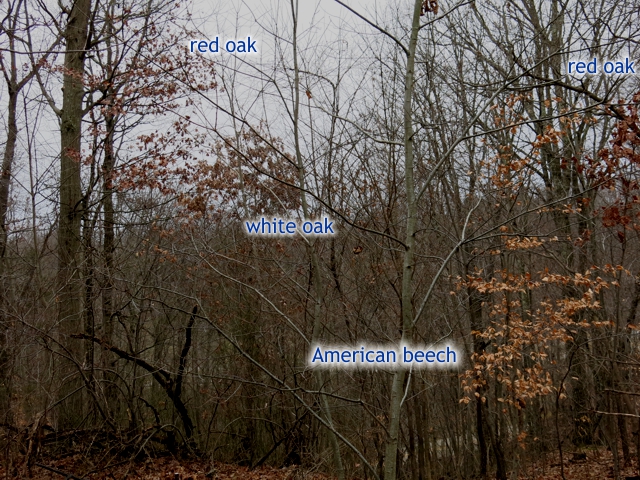
In late fall and winter, the leaves of red oak (Quercus rubra) are a rich brown. White oak (Q. alba) has leaves that are paler and grayer. American beech (Fagus grandifolia) has very pale, almost yellow leaves, and as you walk through the forest in winter, the sapling beech trees are obvious.
The overall shape of a tree can be useful in identification, but it can also be misleading. A tree growing in isolation (in the middle of a pasture, say) has a characteristic shape that varies quite a bit from one species to another. Forest trees, on the other hand, are much more similar in shape. For that reason, features of the bark and morphological details (e.g., branching pattern) are much more useful in the forest.
Red oaks are some of the most common trees in my yard, and they invariably have a bark pattern that is both unique and easy to spot:
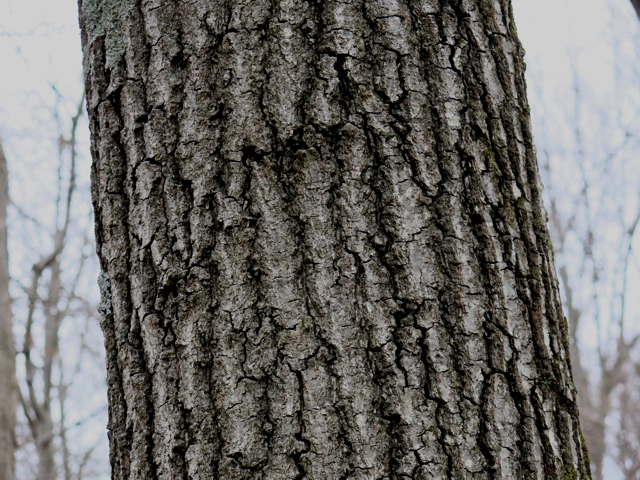
The bark consists of a smooth(ish) medium gray (sometimes slightly brownish) ground interrupted by ragged vertical grooves that are considerably darker. On larger individuals, the bark near ground level may be much rougher than this, but you can always find this pattern if you look at the upper limbs.
The bark of white oaks is very different, a very pale gray (hence the name), flaking off in scales:
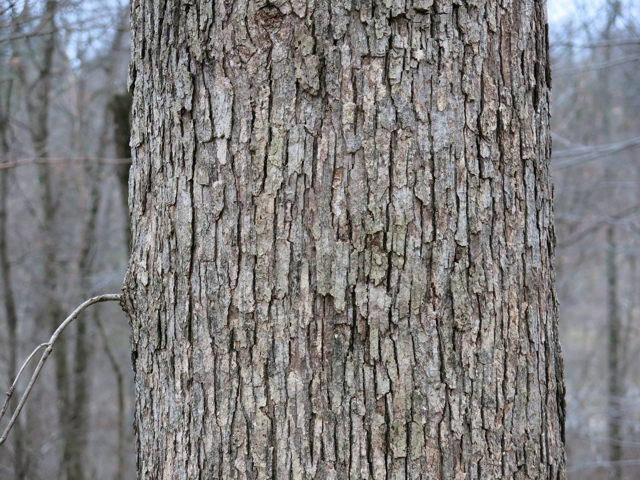
That particular tree has relatively small scales; here’s another (about the same diameter) whose scales are much larger:
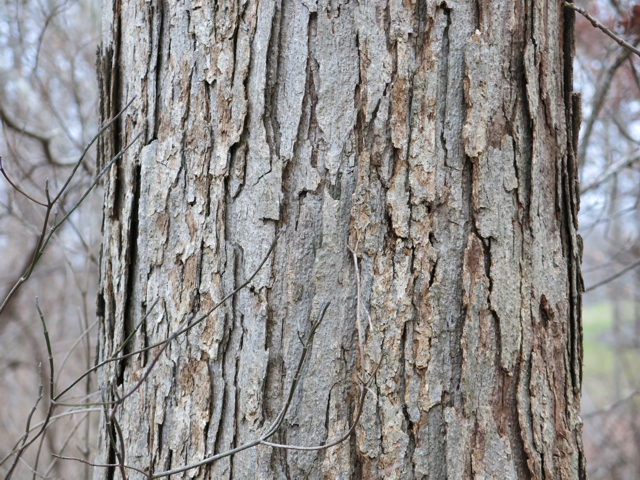
Both red and white oaks are generalists, found in a variety of habitats. There are many other species of oak in Ohio, but most of them have specific habitat requirements. One of these specialists is the chestnut oak (Q. montana):
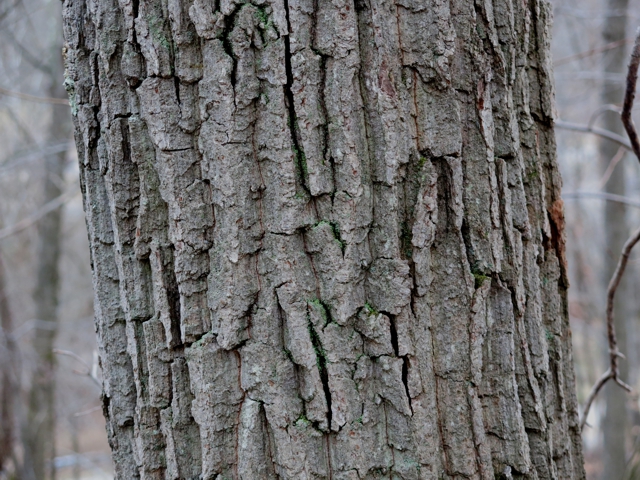
Chestnut oaks are found only near ridge tops, most often on the south-facing slope (which happens to be exactly where I live). The bark of the chestnut oak is dark and deeply furrowed. If you picture a cross section of the tree, the profile of the bark ridges would look something like the teeth of a gear.
Another very common tree in the yard is the red maple (Acer rubrum):
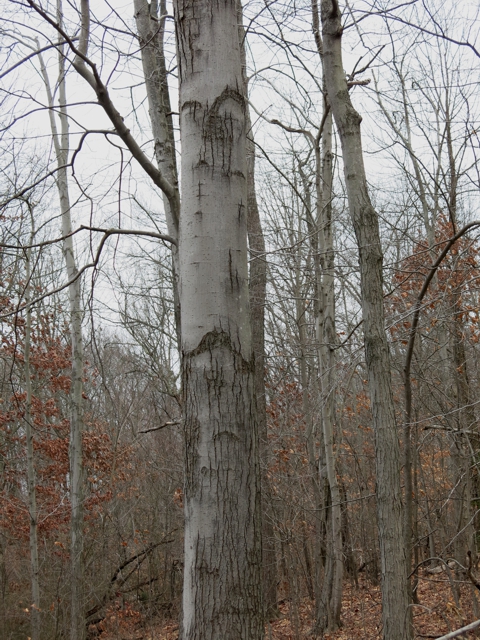
Red maples have a split personality; the bark of young trees is pale gray and very smooth (much like American beech, which I don’t have a photo of here). As the tree grows, the bark starts to split and darken, becoming much craggier. In a large tree, there is no trace of the smooth gray on the bark near the ground, but you can still find it if you look up. The bark of the silver maple (A. saccarhinum) is similar, but silver maples are restricted primarily to bottomland, where the soil contains more moisture. (Red maples, like the two oaks above, are generalists.)
Sugar maple (A. saccharum) has a medium gray bark that flakes off to expose an orangeish background:
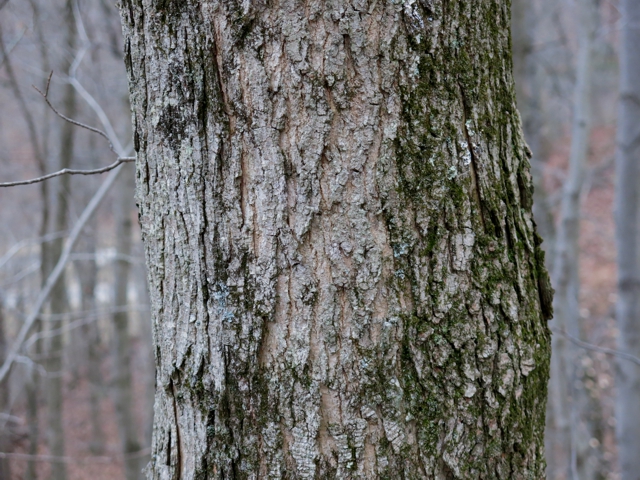
The appearance of the bark is intermediate in all respects, so other than the orange background (which you sometimes see on white oaks, too) there really isn’t any one thing that tells you it’s a sugar maple. It’s kind of a process of elimination.
By the way, late January/early February is the time of year in this part of the country to tap sugar maples for making syrup and sugar. The best sap flow occurs when temperatures cycle above freezing during the day and back down below freezing at night. The prime tapping season is progressively later as you move north, as late as April in southern Canada.
There are two species of ash common in this area, white ash (Fraxinus americana), and green ash (F. pennsylvanica). (To confuse matters, green ash is also known as red ash.) White and green ash have very similar bark, fairly pale overall and consisting of narrow vertical ridges that often cross over each other, forming “X” patterns:
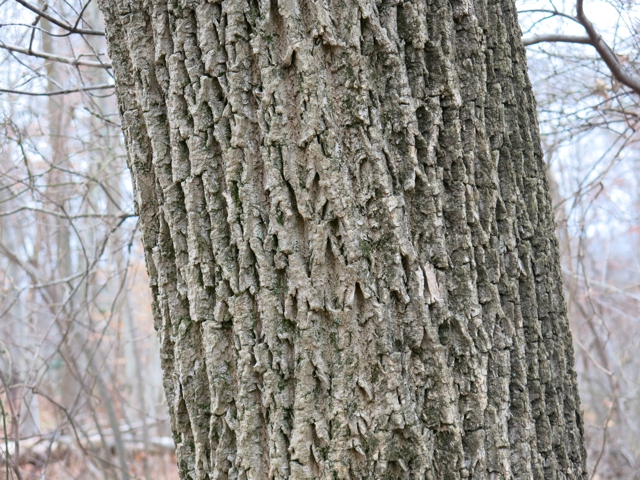
I believe that this example is a green ash, but I can’t be sure without getting a close look at the leaves, and unfortunately the lowest leaves on this tree are about 50 ft. above the ground.
As you may be aware, most of the North American ash species are seriously threatened by the introduced emerald ash borer. It is expected that over 99% of green ash trees will die over the next several years. White ash fares slightly better, but populations of both species (along with black ash, a more northerly species) are being devastated. A small number of individual trees appear to be resistant to the borer, so there is some hope that they will eventually be able to recover.
One of the most important forest trees in this area (Liriodendron tulipfera) goes by many names. The name preferred by the US Department of Agriculture (USDA) is “tuliptree,” but woodworkers know it as “yellow poplar,” “tulip poplar,” or even just “poplar” (which is especially misleading, as it is unrelated to true poplars):
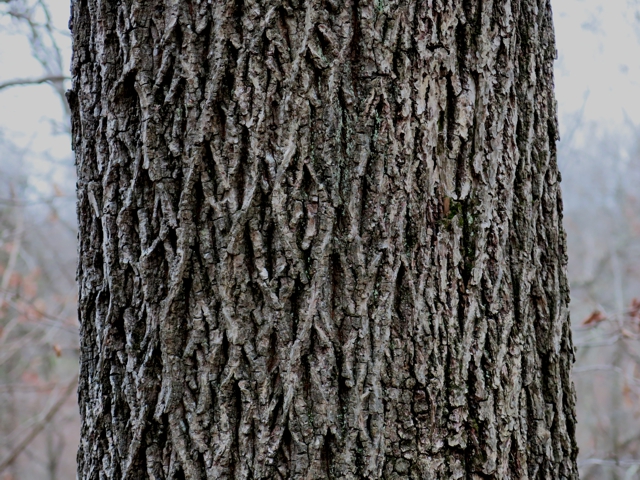
(EDIT: As pointed out by “A Riving Home” in the comments, this is actually a mockernut hickory. I had taken photos of both it and the tuliptree, then decided to save the hickory for a later post, and managed to get the two photos mixed up.)
The bark of tuliptree is much like that of ash, with narrow vertical ridges, but is overall quite a bit darker, sometimes appearing almost black. This particular individual has a lot of the same sort of “X” pattern that ashes do, but not all tuliptrees show this. Tuliptree is one species where the overall shape of the tree is useful in identification, even in the forest: tuliptrees are arrow-straight (usually the straightest, most vertical trees in the forest), and the branches are restricted to the very top of the tree.
Here’s another tuliptree, with a big problem:
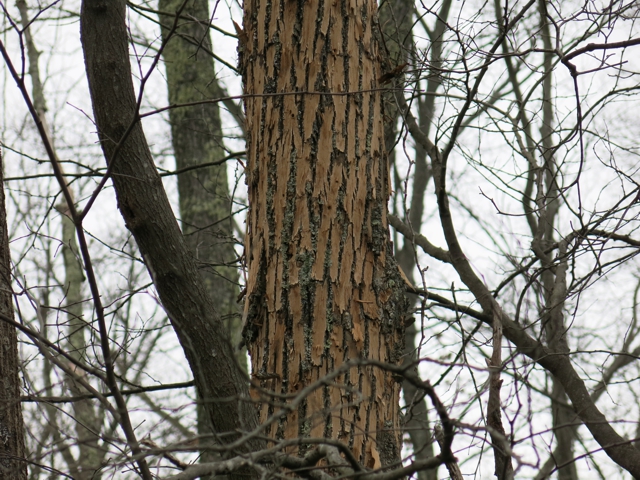
During the summer of 2015, we had a spell of very hot, dry weather. Many of the tuliptrees in this area and neighboring West Virginia were weakened and eventually killed by the drought. Some of these dead trees are now exhibiting this odd pattern of flaking bark.
Not every tree loses its leaves in the winter, of course. American holly (Ilex opaca) is primarily a tree of the southeastern forests, but there are a few scattered small hollies in my yard, such as this one, which is about 8 ft. tall:
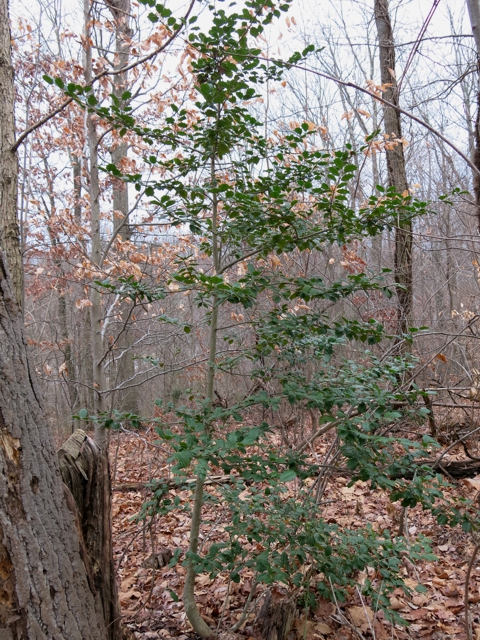
I haven’t been able to figure out whether these individuals are native, at the very northern limit of their range, or escaped from cultivation. There is no record for Athens County for the species in the USDA PLANTS database, but there are records from some of the surrounding counties.
Incidentally, a good place to see much larger (and definitely native) American holly is along the Baltimore-Washington Parkway in Maryland.
The leaves of American holly make it easy to identify:
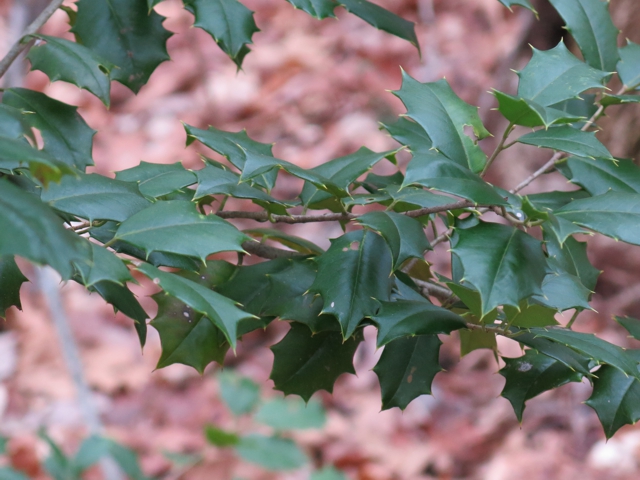
The leaves are a dark, shiny green, about two inches long and with very sharp spines along the margins.
Another bit of green in the yard comes from a scattering of eastern redcedar (Juniperus virginiana):
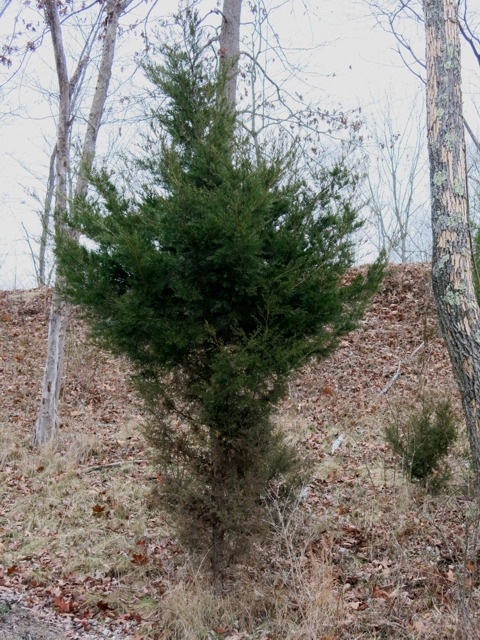
Redcedars are normally more conically shaped than this, but this is what happens when your yard is overrun by deer. As the scientific name suggests, redcedar is not actually a cedar, but a kind of juniper. The wood that is sold as “aromatic cedar” comes from this species.
Interestingly, redcedars have two kinds of foliage. On the upper part of the tree, the foliage has a typical juniper-like appearance:
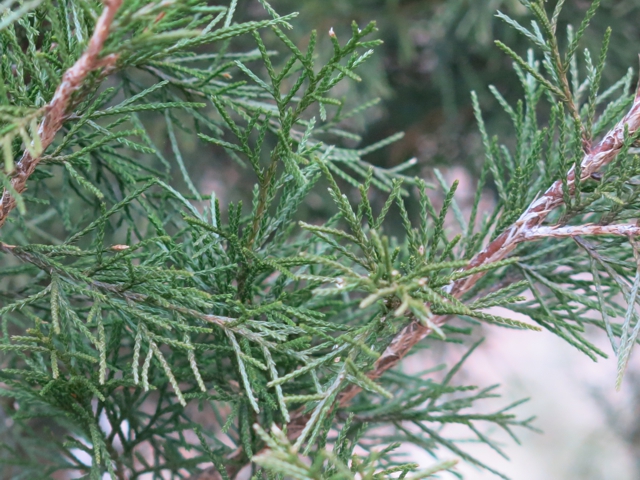
But seedlings and the lower portion of trees that have been ravaged by deer have a much different foliage:
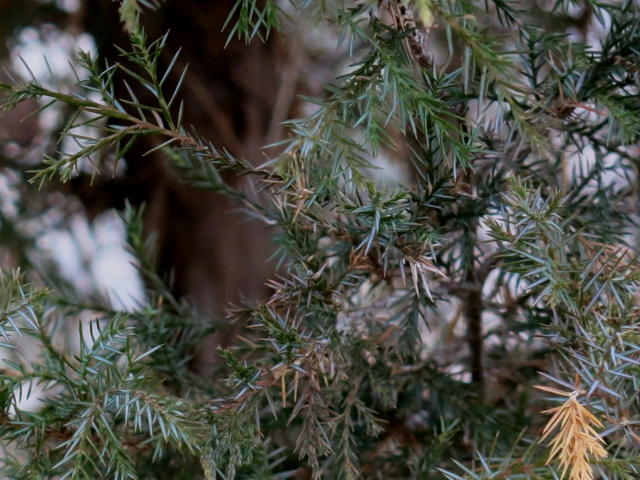
This juvenile foliage is quite prickly, and is an apparent attempt by the tree to dissuade browsers. It seems to work for the seedlings, which don’t get munched too badly, but it obviously doesn’t for the larger trees.
In addition to the large trees that make up the forest canopy, there are smaller trees that form the understory. One of the more common understory trees in the yard is flowering dogwood (Cornus florida):
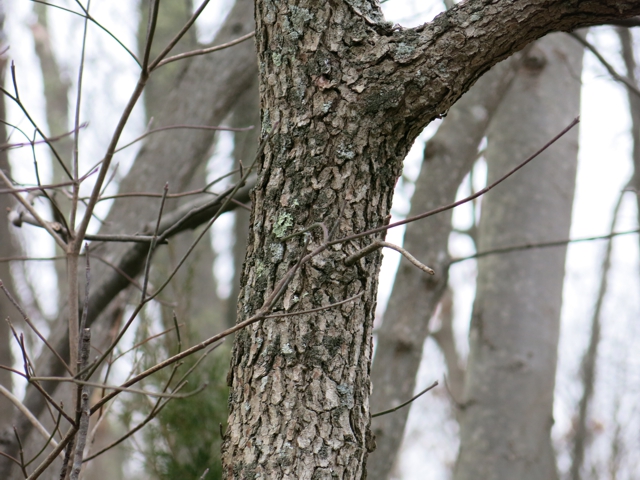
The trees are small, usually less than 6″ in diameter, and the bark is broken up into numerous small roundish plates. But the easiest way to identify a dogwood in winter is the flower buds, which are usually plentiful and have a characteristic turban-like shape:
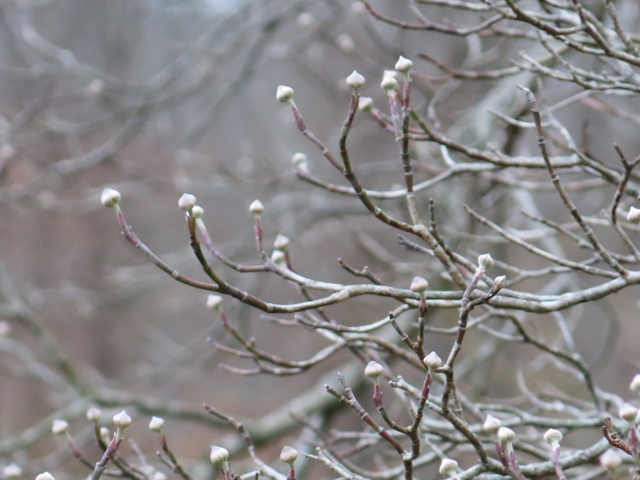
That’s it for now. I hope this inspires you to take a walk in your own woods. (Did I mention that there’s going to be a test later?) If you do, a couple of cautions:
- Remember that poison ivy (poison oak in the west) is plentiful in the forest, especially around openings, and like the trees, sheds its leaves. Be careful what you touch.
- Before walking in the forest, check with your state wildlife agency to determine the deer season dates for your area, and be sure to wear appropriate orange clothing if there is any chance of being in the same forest at the same time as a hunter.
–Steve Schafer

What do you mean California is excepted? At least here in Central CA, the weather is definitely very gray and fairly chilly – though maybe not as chilly as Ohio. (I was born in Wisconsin, so I know wherefore I speak.) We don’t get some of those species out here, but I have a native in my front yard you are not likely to see – a grove of five redwood trees.
I grew up in the Bay Area, so I know what you’re talking about. As a kid, I thought the definition of “winter” was “when it rains,” and “summer” was “when it doesn’t rain.”
A really interesting blog post,Steve, thanks. I felt very much at home in your woodland even though I live in the UK. We have similar trees, I guess filling the same ecological niches, but different species- English Oak (Quercus robur) or sessile oak further West (Quercus petraea), field maple (Acer campestre) or the introduced sycamore (Acer pseudoplatanus) and common ash (Fraxinus excelsior). A typical understory shrub would be hazel (Corylus avellana). We even have our version of the problems caused by the emerald ash borer- chalara or ash dieback, a disease caused by a fungus called Hymenoscyphus fraxineus which has devastated ash tree populations in Europe and has arrived in the Britain. Green woodworkers especially wait with trepidation to see what impact this wind-blown disease will have on our majestic ash trees.
Steve,
Best walk in the woods I’ve had this winter. I never felt a chill !
You should plan more walks in the coming seasons.
Thanks!
This was a great post. Keep them coming! >
I loved this post!! Would like to see more.
Great post, Steve. Wood identification appears to be one of the biggest challenges many woodworkers face. Walking through the woods with a tree identification book for your native area is something woodworkers should do periodically, I think. If you don’t know what kind of wood you’re working with, then you’re making your job harder because you can’t use the wood’s inherent qualities to your advantage.
Keep up the varied posts, Steve!
You need this book
http://www.amazon.com/Winter-Tree-Finder-Identifying-Deciduous/dp/0912550031
Fabulous post. It took me back to my college days in Plant Materials class, which I took during the winter when there were no leaves to help with ID. Consequently, I learned by bark. Your description are so right on especially nice in your words that all can understand. This article is great for woodworkers, how can one truly become a “woodcharmer” without feeling the tree? Thank you very much.
Last year we tapped maples to make syrup for the first time. To make sure we got the best quality sap, we identified all the candidate sugar maples and marked them the previous fall while the leaves were turning. It was a lot of fun and we were motivated to get it right. But my favorite tree to identify on a walk is an abandoned apple tree!
Very nice! I need all the help I can get.
Thanks, Steve. Can’t say how many times I’ve found myself waiting for leaves to make a good ID. I was surprised to find our local park here (Pittsburgh) took out an acre of Aspen that was 35 years old, which, they say, will all grow back because of the root system. Managed to get some branches for shrink pots and spoons, which carved very well. I didn’t even know Aspen grew around here. Would love more help like your post. Thank you!!
Steve, thanks for the walk in your woods. Your woods look much like our woods here in central Maryland. Deer have done significant damage, eating nearly all the underbrush. One curious thing is that while they eay holly hybrids almost to the ground, they leave American Holly alone.
Steve,
Thanks for the post. I’m a forester so I totally dig it.
Our dendro final was in the winter which made tree id hard but it truly is the best way to learn.
One cool thing about Eastern red is that as you drive east from the plains on I-40 they get very columnar. If you take those same trees back to Oklahoma they lose that tendency. I’m talking about direct transplants. Nobody knows why.
Great dendrology lesson! I will share it with our Scouts!
Thank you for this nice blog piece. It reminded me of the richness of the Eastern hardwood forest we enjoyed living in the Finger Lakes area of New York, with its tuliptrees, beeches, sycamores and many others we don’t often see here in Minnesota. While we may not have “tulip poplars,” we do have a few species of regular (Populus) poplars that are part of the fun to sort out in the winter woods. In particular, the bark of mature cottonwoods, P. deltoides, can often look much like that of the red oaks in texture, but with color reversal, the vertical cracks being lighter instead of darker, as in red oak.
In the winter woods around here, it’s much easier to sort out the occasional black oak (Q. velutina) from the abundant red oaks (Q. rubra). Burr oak (Q. macrocarpa) can be tricky. Often the bark on mature trees is thick and coarse, like red oak, only moreso. But on some mature trees, the bark seems to collapse and can come to resemble that of white oak. And then there’s sorting out the native northern pin oak (Q. ellipsoidalis) from introduced look-alikes Q. palustris and Q. coccinea, difficult to do in any season, but fun to think about on winter walks.
The pin oaks tend to hold their leaves tenaciously until early spring, as do the swamp white oaks (Q. bicolor) and some red oaks. But the most common tree that retains leaves all winter in our woods is the American hop-hornbeam (Ostrya virginiana). I can see several out my window right now. The bark of this tree is unmistakable brown with a regular, almost tailored-looking, pattern of furrows.
One reason for learning to know trees in the winter woods was that winter used to last so long in these parts. Seems to be shorter and certainly milder these days, but we still have several months to know the trees mainly by their bark. Thanks again for this look at your woods.
Great post, with one exception: The first picture of “tulip-poplar” is actually a hickory. Probably mockernut hickory, but I can’t say with certainty without seeing the tree in person. The diamond-shaped interlacing ridges punctuated by small vertical breaks is diagnostic for several hickory species. An easy way to reliably identify hickory bark in person is by the hardness. If you try to cut into poplar bark with a knife, you’ll find that it’s rather soft and corky (and the same for most trees with similar bark, like ash). Try the same thing on a hickory tree, and the knife will skitter off due to its impressive hardness.
You’re absolutely correct, it is a mockernut hickory. I took photos of both it and the tuliptree, but decided to save the hickory for another post, after I got some more photos of other hickory species. I then managed to inadvertently swap the photos.
I love the textures of these beautiful trees. Lovely post.
Enjoyed looking at your bark photos!